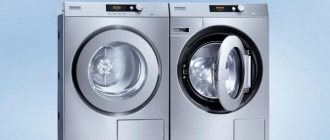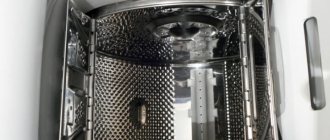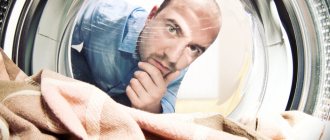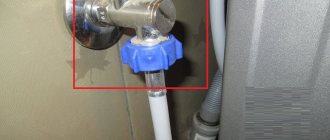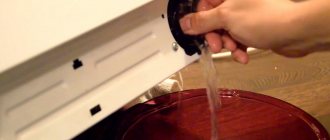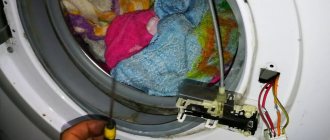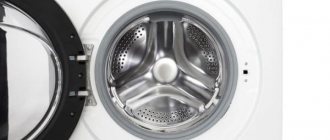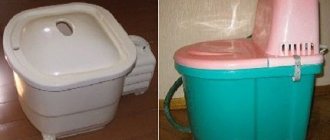Many people remember the Soviet Eureka washing machines well. Such high-quality equipment still faithfully serves its owners. Semi-automatic washing machines are still actively used in everyday life, despite the popularity of SMA. Let's look at the features of these semi-automatic machines.
- History of the Eureka brand
- Features of washing machines of this brand
- Principle of operation
- Advantages and disadvantages
- Model overview
- Expert recommendations
- Consumer Reviews
- Catalog of washing machines with characteristics
History of the Eureka brand
The production of Eureka washing machines began in Soviet times. Today the plant produces modernized versions of its semi-automatic machines.
To improve the consumer qualities of the equipment, the engineers of the Aviamatika Research and Production Center improved the Eureka machine models that were popular at the time, while maintaining their positive characteristics. The original name of the devices was shortened to “Evry”.
washing machine Eureka semi-automatic 3m
The company uses manual assembly of the main components, in contrast to large factories focused on conveyor production. All products undergo quality control. Experienced specialists from the Aviamatika network of workshops carry out diagnostics and repair of washing machines using standardized spare parts.
Features of washing machines of this brand
Eureka washing machines have gained popularity due to their economy and efficiency. Among the distinctive features of the brand’s devices are the following:
- Low price. This is a good option for saving money on the family budget.
- Small dimensions and weight. The machine will not take up much space, and rearranging it or transporting it in a passenger car is absolutely not difficult.
- Vertical loading. Allows you to add things while the unit is operating.
- Easy controls. A clear interface with inscriptions in Russian, detailed instructions included.
- Quick results. You can freshen things up in 10 minutes.
- Practicality. The presence of two tanks allows you to wash and spin clothes at the same time.
- Automation of washing, rinsing, spinning processes. In this case, it is allowed to use equipment without connecting to the drainage system.
- Reliability. Even washing machines with extensive experience will not let the owner down.
These machines really rarely break down. Users note that the devices operate flawlessly for many years. Even impacts from a fall do not disable them.
How to turn on a commutator type engine
The appearance of motors of different models may differ, but the design and operating principle are almost identical. The device consists of:
To connect the motor, you need to know the outputs of the armature, stator, and tachometer windings. The tester will help you avoid getting tangled among the wires.
How to connect an electric motor
Set the tester to the mode of least resistance, call the windings of the tachometer, coils, and armature. Make connections through the terminals that connect to each other to find a pair. If you have a design with 4 wires, then red-brown are the stator, gray-green are the rotor. The colors of the wires of different SMA models may differ. Therefore, use a multimeter. Did you get a device with 6 wires? Those on the left regulate the speed of the machine with a tachometer. Their resistance is about 70 ohms. A correctly connected device picks up speed smoothly, does not crackle, does not spark. You can check how many revolutions the motor makes using a speed sensor.
You can see how to start the engine from the washing machine here:
Rotation adjustment
There are many ways to control speed:
The adjustment scheme is simple, you can do it yourself.
This is a satisfactory option for a pump or fan. More powerful mechanisms (for example, machine tools) will require a different regulator circuit.
The essence of the issue is to reduce the speed while maintaining performance. The connection is made through a tachogenerator, which transmits the number of turns to the speed controller microcircuit, which coordinates the cycle with a thyristor.
This board allows you to increase or decrease speed, but requires constant, intense cooling due to overheating. A detailed video about adjusting speed, stroke force, and connecting the microcircuit can be viewed here:
Principle of operation
The instructions will help you understand the functionality of the machine. The device is a structure consisting of the following main elements:
- collapsible stainless steel case with decorative coating;
- tank;
- Control block;
- pump for draining;
- removable water filter;
- hidden niche for electrical cord.
Washing machine Eureka semi-automatic
The control unit contains a mode switch, a timer, and a water level indicator. The manufacturer recommends starting with sorting laundry based on color, degree of soiling, and fabric texture. Pre-soaking dirty clothes will achieve better results. Followed by:
- heat the water to the desired temperature and fill the tank with it;
- add powder or other detergent;
- load laundry;
- connect the machine to the electrical network;
- set a timer;
- transfer items to the spin container after the end of the wash cycle;
- Remove and dry the wrung out laundry.
For semi-automatic machines, detergents for hand or machine washing are suitable. Spinning the first batch can be combined with washing other items in the second tank.
Are you unplugging your washing machine?
Oh yes! No
Advantages and disadvantages
The owners of Eureka note that it has its pros and cons.
The advantages of using this machine include:
- reasonable price;
- low consumption of water and electricity;
- saving time;
- good work results;
- versatility - the ability to use any powders;
- adding additional things along the way;
- wear resistance of the device;
- availability of different washing programs;
- additional vibration sensor for smoother movement of the tank during spinning;
- inexpensive spare parts;
- possibility of washing in the absence of connection to the central water supply.
Some inconveniences in operation are caused by:
- Requirement of user presence. In order not to flood the neighbors, the process has to be controlled.
- Some operations are performed manually.
- To purify the water, you will additionally need to purchase a filter.
- The machine does not allow you to load a large amount of laundry.
Despite this, at a low cost, the user of these machines receives benefits that can satisfy his needs for keeping things clean.
washing machine Eureka semi-automatic 86
What to do in case of breakdown
The Eureka washing machine is resistant to breakdowns and works smoothly. But each technique has different failures, namely:
Situation 1. The motor is running, but the spin is not. This often happens when the tank is overfilled. To continue working, you need to remove some of the laundry. If after this step nothing has changed, then it is worth checking the serviceability of the brake on the centrifuge of the Eureka washing machine.
Situation 2. The motor of the Eureka washing machine does not work when switching to another mode. In this case, you will need the help of a specialist who will carry out diagnostics. Surely one of the parts has become unusable - a capacitor, a shield, a relay, a transformer. The technician will determine which one is needed and replace it. Less often, the Eureka car engine does not work at the moment of switching if the wires break somewhere. In such cases it is necessary to check the circuit .
Situation 3. The washing equipment engine is running, but the motor is still in place. This may indicate that the linen has become loose or the diaphragm bushing has become unusable.
Situation 4. The centrifuge of the Eureka machine does not work. The most common reasons that create this situation are: a malfunction of the protective sensor, a drive belt coming off, problems with the timer.
Situation 5. The Eureka washing machine is leaking. This problem most often indicates that the drain valve or tank is damaged. This may also indicate a breakdown of the drain pump or a weakening of the rubber cuff.
Situation 6. The Eureka electric motor does not start. The reason may be not only its breakdown, but also a malfunction of the power cable. Recommended actions are to repair the motor and replace the cable.
Situation 7. Liquid enters the centrifuge. Most often, this occurs due to a clogged bypass valve. Recommended actions - cleaning of this element is required. The washing machine must be turned off and without water.
Model overview
Among the semi-automatic machines of the brand, the following models are the most popular: “Eureka-3”, “Eureka-86”, “Eureka-92”. They share similar technical characteristics:
- the washing tank is fixed in racks;
- a perforated drum is installed inside the tank;
- the tank with drum is made of stainless steel;
- Loading of laundry is carried out through the hatch;
- an asynchronous motor starts the drum reverse mechanism;
- a centrifugal pump pumps out soapy water using an electric motor;
- there is a hatch providing access to the pump and filter;
- The indicator sensor allows you to control the level of filling of the tank with water;
- the volume of water for one load of laundry is no more than 40 liters;
- the most economical energy consumption class (A);
- There are two washing modes (gentle and intensive), several rinsing options;
- You can load a maximum of 3 kg of laundry;
- When washing, the drum rotates at a speed of 55 rpm, when spinning - 390 rpm.
In addition, the devices are equipped with running rollers, which makes them mobile.
Do you wash by hand?
Oh yes! No
If the water fill does not work, we carry out further repair work:
- Even before disassembling the housing, it is necessary to manually check the hoses and their connections for leaks.
- Next, disassemble the machine to gain access to the drainage pump.
- Remove the pump, clean it and put it back (check if the impeller is broken).
- Check the associated components - diaphragm, gaskets and membranes. If you find defective parts, install new ones.
- Remove the tank and inspect it for damage.
- Having found the holes, seal them with sealant or CS. Let the product dry, then reassemble the washer.
Expert recommendations
To extend the life of the machine and not resort to repairs, you should follow the included instructions and also monitor the integrity of the external and internal surfaces of the device. It is not recommended to place heavy objects on the machine. It is necessary to keep household appliances clean, promptly removing residual detergents and scale.
"Eureka" has proven itself to be a reliable and durable home assistant. Even voltage surges are not scary for her. The stainless steel from which the machine parts are made is practically not subject to wear.
Therefore, during normal operation, the equipment will serve for a long time and without failure.
A review of Eureka semi-automatic devices showed their advantages and disadvantages. The quality of such equipment has been tested not only over years, but over decades. They are practically unkillable. Soviet washing machines still represent a certain consumer value. At a low cost, the buyer receives many advantages.
Video
How to turn on an asynchronous type motor
The asynchronous system consists of:
The SM used three-phase motors that can fully operate at a voltage of 380 V. Connecting the motor from the washing machine to a single-phase 220 V network requires connecting a capacitor.
It will reduce the power of the device, but will make the work safer.
Choose a capacitor more powerful than the motor, then it will withstand voltage surges.
Three-phase connection diagram
You will need a set of accessories:
Connection:
If you cannot hear the motor noise after plugging it into the outlet, most likely the starting capacitor is connected incorrectly. You will have to look for the right terminal using the “scientific poking method”. A detailed description and the result of the experiment with three wires can be seen in this video:
Consumer Reviews
In a budget option or for a dacha, or if you are too lazy to bother connecting the machine. And it’s not a waste of time to periodically approach the machine to add water and continue the cycle.
Eureka EVRY K-507 Anatoly
Used in the country for years... 15. It is impossible to kill. At one time it was a successful design. Well, it’s a semi-automatic machine, you fill the water with handles, the tank is rigidly fixed to the body, so it jumps on the spin cycle like a bun - and it will get away from your grandmother, and from your grandfather, and from those who are younger and stronger. If there is no running water and you drag water from the well with handles, then it will work, but if there is, then it’s better to buy an automatic machine for the money.
Eureka EVRY K-507Maxim
Advantages: Indestructible, fell from a pedestal 20 cm to the side -2 times... worked after it had not fallen... of all the breakdowns, only the water fill indicator (float) broke... and nothing else... Disadvantages: When loading 3 kg on the spin cycle, the whole machine starts pounding for seconds 5... at this time, if you don’t hold it, it can even fall to the side... after 5 seconds the load levels out and there is only a slight rocking Comment: good car... I’ve had it for 15 years and before that my sister worked for 5 years
Eureka EVRY K-507Denis
Previous
Next
How to prepare for disassembly
De-energize the device
Never disassemble the washing machine with the power on. This will harm the machine and, first of all, its owner.
Turn off the water supply
Turn off the water supply to the machine, as well as the drain hose leading from the water valve to the sewer. And drain off the remaining water.
Get these tools ready
- service hook;
- wrenches with a diameter of 8, 9, 19;
- flat-head screwdriver;
- Phillips head screwdriver;
- wire cutters or pliers needed for clamping clamps;
- construction nippers;
- pliers with insulated handles;
- curved pliers (somewhat similar to tongs).
Record the disassembly sequence
We recommend recording or filming the disassembly process; this will save a lot of time in the future when you start putting the washer back together.
